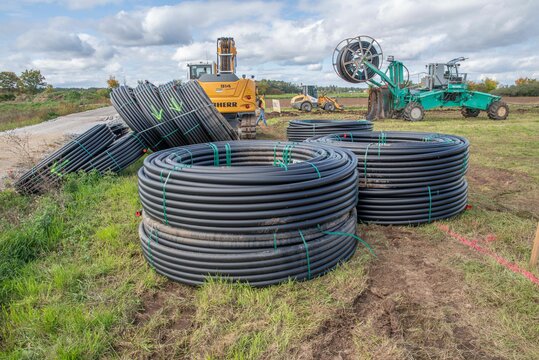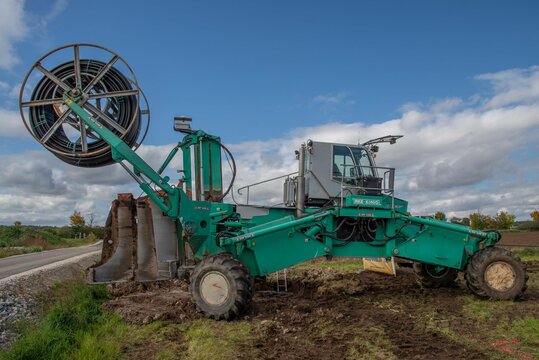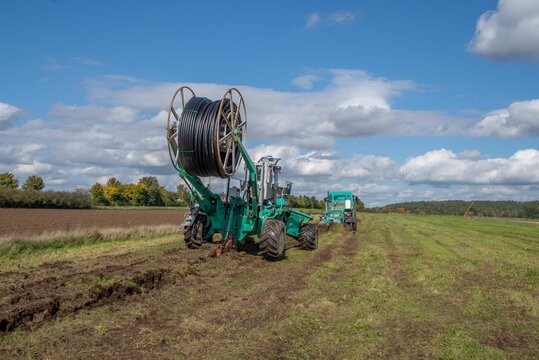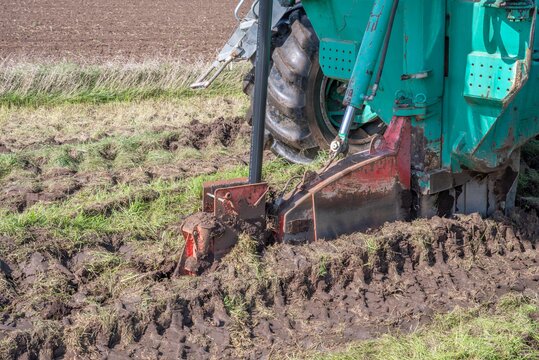As part of the City of Nuremberg’s special housing programme, the Kornburg-Nord site was transferred to WBG Nürnberg Beteiligungs GmbH. This company is developing the area north of the street “Am Bruckweg” and east of Seckendorfstraße in Kornburg with owner-occupied houses and flats. The City of Nuremberg has always wanted to carry out an ecological and energy-efficient urban expansion on this site.
In 2019, energy-efficient buildings were erected with the aim of creating a future-oriented, sustainable neighbourhood, with heat being supplied via a central local heating network using wood pellets. The cooperation entered into for this purpose with the regional energy supplier N-ERGIE will now be continued for the further construction phases.
The motto “Use the energy stored under our feet” will in future be made possible by N-ERGIE for the residents of the RieterBogen residential area in Kornburg. A pipeline plough is currently underway in a field, digging a total of roughly 16 kilometres of pipelines to a depth of about two metres. The plastic pipes are laid horizontally and are part of a near-surface geothermal horizontal collector covering around 1.3 hectares.
“In Kornburg, we are implementing our first near-surface geothermal project”, explains Gregor Mannl, Head of Plant Technology at N-ERGIE Kraftwerke GmbH. It is one of the largest plants of its kind in northern Bavaria. “For the heating turnaround to succeed, we need to exploit the potential of all heat sources”, Mannl continues. For the project, only such a near-surface solution came into consideration, as geothermal probes are not possible due to the soil conditions in Kornburg.
This is how geothermal heat reaches around 100 living rooms
Solar radiation, seeping rainwater and air temperatures ensure that the ground stores heat, which can be used again when needed, especially in autumn and winter. A heat transfer medium in the pipe collector extracts heat from the ground and transports it to the buildings via a local heating network with a total length of approx. 2.5 kilometres. This is referred to as “cold local heat”, because the connected 100 houses and flats are supplied with heat from the heat transfer medium with a temperature of merely 8 degrees or less. In order to be able to use this local heat temperature for heating and hot water, each building is equipped with a heat pump, the electricity for which is generated in part by photovoltaic systems on the roofs of the houses.
Here, primary energy factors of below 0.4 are achieved thanks to the well-chosen heat pumps in the houses. Carbon emissions are reduced to less than half of that of a conventional heating system and can be further reduced through the use of photovoltaic electricity.
In the coming months, the collector and the associated local heating network will be constructed, so it will be possible to heat the first buildings by the end of the year. The local heating network is expected to be completed in 2024. Once the work is complete, the horizontal collector installation will be invisible and the field can be used for agriculture again.
“We are delighted to have succeeded in acquiring N-ERGIE as a partner for this extremely innovative and highly ecological project. This enables us to fulfil the long-standing wish of the City of Nuremberg to implement an exemplary climate-neutral concept as part of urban expansion. The fact that we are implementing this in the scope of our activities as a property developer here in Kornburg is also something special and by no means typical in the industry”, explains Kristian Lutz-Heinze, wbg authorised representative and Head of Property Development, during a tour of the construction site.
In the RieterBogen quarter, named after the patrician Rieter family, around 150 residential units will be built by 2025 in the form of condominiums, terraced houses and semi-detached houses.





